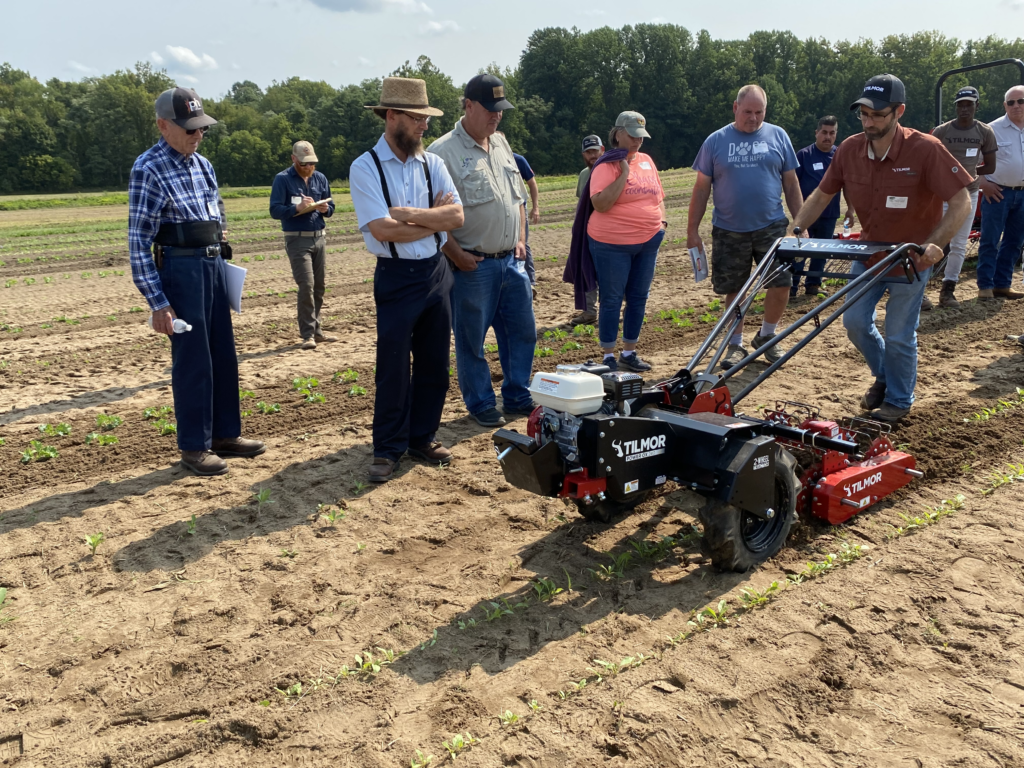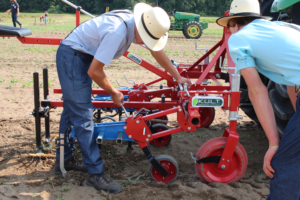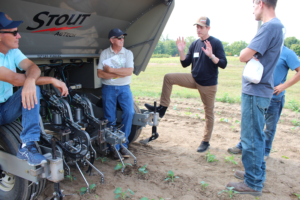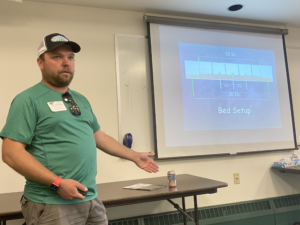

Nov 1, 2022Midwest Weed Tech: Weed-fighting strategies, equipment have field day
BENTON HARBOR, Michigan – Hans Bishop diligently sets the stage when approaching weed control on his farm.
He always develops a crop plan, refers to the farm’s previous performance records, strategizes what, where and when to plant and finally, always keeps “Thine Enemy” in mind.
Bishop, co-owner of PrairiErth Farm in Atlanta, Illinois, was a featured speaker at the sixth annual Midwest Mechanical Weed Control Field Day, billed as the nation’s largest field day focused on mechanical weed control, which returned to an in-person outing this year.
The field day, which included an expo and demonstrations, was in mid-September at Michigan State University’s Southwest Michigan Research and Extension Center in Benton Harbor.
The event offered opportunities to view weeding tools from several companies and to network with the growers in attendance from throughout the U.S. and Canada. University weed scientists from surrounding states and farmer-experts shared their experiences. Walk-Behind Alley featured demonstrations of walk-behind tractors and implements.
In the afternoon, attendees followed the tractors to the demonstration field, where corn, beets and cabbage were planted for the demonstrations. Several cultivators and cultivating tractors were demonstrated to show how the machines should be mounted and adjusted, to help growers visualize how the implements could work on their own farms to increase efficiency and productivity.
Return performance
Bishop hosted the field day on his farm in 2018. He told attendees that while his operation grew 80 acres of vegetables a year ago, this year that was reduced to 10 acres and will be completely phased out next year as PrairiErth Farm becomes solely a row crop outlet, harvesting primarily corn, wheat and beans.


Bishop said that “a lot of the effectiveness of the tools that you have are going to be as good as what you’ve done before you’ve drug the steel into the field to try to cultivate. If you’re planting one row at a time with a planter and one row zigs, and the other one zags, they’re not going to cultivate very well.
It’s also important for growers to do their homework and develop a crop plan. Specifically, when growing vegetables, “you want to try and stick to a crop plan, refer to your records – whether that’s fertility, or what crops were in what fields before. Even disease can affect weeds because you have less canopy closure. If you have black rot you’re going to lose canopy and there’s going to be more weeds coming up.”
Consider what weeds were in the field before.
“If you had a cover crop that went to seed, like buckwheat, you may not want to plant something like carrots in there. It’s something that’s going to be more sensitive to weeds.”
Bishop said when he first started mechanically cultivating, he didn’t recognize how tillage can help grow weeds, as well.
“Deep tillage isn’t bad. Maybe you’re doing some fall tillage deep ripping, and you’ve had a foxtail problem in that field. Deep ripping can help improve your drainage which may make the conditions less ideal for foxtail to grow in.”
No-tilling a cover crop after mowing it can produce hidden benefits.
“Maybe over the winter there’s going to be predation of birds and mice, whatever’s out there that might feed on the seed of the weeds over the winter. You’re going to lose some weeds that way.”


“If it’s going to be a fallow field, tillage is good. Stale seed bedding is something I’m a proponent of, particularly in vegetables, and even in soybeans.”
Bishop advocates using the stale seedbed technique based on the premise that weeds that germinate and emerge before the crop is planted are easier to manage.
Set the stage for success
Detail matters at every step, Bishop stressed.
For vegetables, Bishop seeks evenly formed beds, with “the wheel tracks in the same spot. All of the beds are probably the same height, so it’s going to be the same for all of your tools on all of the beds.”
Soil health is vital. Proper soil management will give plants, whether they’re transplanted or direct-seeded, a jumpstart coming out of the ground.
“You’re going to have more predictability and uniformity. Everything is going to close the canopy at the same time, hopefully. Things are just going to work better if you have more uniform utility in the system.
“Things that you might not necessarily think about, like cover crops, are going to help your soil tilth and you have less compaction. Your hills are going to drain faster and you’re going to be able to get tools into the field at a more ideal and predictable time. Your soil is going to fracture at the same rate and you can move the same rate of soil for each row for your crop.”
Bishop uses a rotavator to incorporate cover crops because it effectively breaks up all of the root balls.
“Then you can go and form a good seed bed with either raised or flat beds. Then you’re not going to have root balls of rye getting stuck on points of cultivators and stuff like that when you do a primary tillage pass with good intention,” he said.
Bishop said flaming is another good way of stale seed bedding “where you’re not even doing any tillage. It depends on what kind of weeds you have a problem with. Flaming is not necessarily a good mode of attack against something like foxtail or grass because the growing point is below the soil.
“I’m just trying to bring up ideas that really made our weed control systems click as we graduated into different stages of our vegetable farming career,” he said. “Once we got better irrigation we were able to force a flush to come up.
“We would do something like pull out the big traveling gun and just irrigate empty beds to get a many weeds to come up as possible. Especially with summer-planted carrots we’d have six weeks where it wouldn’t rain in the summer. So, how are you going to get weeds to come up if you don’t have the moisture? We’d pull the traveler out, get the weeds to come up, do a stale seed bed. It feels like you’re wasting water but the (weeds) are going to come up when you plant your carrots and it’s just a disaster.”
—Gary Pullano
Top photo: Field day attendees view a mid-mount cultivation set-up on a Tilmor tractor. Photos: Gary Pullano
Second photo: Hans Bishop, co-owner of PrairiErth Farm in Atlanta, Ill., speaks about his experiences during the Midwest Mechanical Field Day in Benton Harbor, Michigan.
Third photo: K.U.L.T.-Kress LLC demonstrated its in-row weeding equipment technologies.
Fourth photo: Stout AgTech CEO Brent Shedd explains the features of the company’s Stout Smart Cultivator, a software-defined, tractor drawn implement that uses machine vision and artificial intelligence to cultivate and weed fields using mechanical blades.















